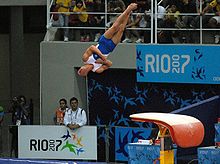Apparatus
Both male and female gymnasts are judged on all events for execution, degree of difficulty, and overall presentation skills. Diego Hypolito vaulting from a modern vaulting table during the 2007 Pan American Games. Vault The vault is an event as well as the primary piece of equipment used in that event. Unlike most of the gymnastic events employing apparatuses, the vault is a common to both men's and women's competition, with little difference between the two categories. A gymnast sprints down a runway, which is a maximum of 25 meters in length, before leaping onto a spring board. Harnessing the explosive energy of the spring, the gymnast directs his or her body hands-first towards the vault. Body position is maintained while "popping" (blocking using only a shoulder movement) the vaulting platform. The gymnast then rotates his or her body so as to land in a standing position on the far side of the vault. In advanced gymnastics, multiple twists and somersaults may be added before landing. Successful vaults depend on the speed of the run, the length of the hurdle, the power the gymnast generates from the legs and shoulder girdle, the kinesthetic awareness in the air, and the speed of rotation in the case of more difficult and complex vaults. In 2001 the traditional vaulting horse was replaced with a new apparatus, sometimes known as a tongue or table. The new apparatus is more stable, wider, and longer than the older v

ulting horse—approx. 1 m in length and 1 m in width, gives gymnasts a larger blocking surface, and is therefore safer than the old vaulting horse. With the addition of this new and safer apparatus, gymnasts are attempting more difficult and dangerous vaults. Floor exercise The floor event occurs on a carpeted 12m ? 12m (40' ? 40') square, called a "spring floor," which consists of hard foam over a layer of plywood, which is supported by springs or foam blocks. This provides a firm surface that will respond with force when compressed, allowing gymnasts to achieve extra height and a softer landing than would be possible on a regular floor. A series of tumbling passes is performed to demonstrate flexibility, strength, and balance. The gymnast must also show strength skills, including circles, scales, and press handstands. Men's floor routines usually have four passes that will total from 60 to 70 seconds, and men perform without music (unlike women gymnasts). Rules require that gymnasts touch each corner of the floor at least once during their routine. Female gymnasts perform a 70-90 second long choreographed routine to instrumental (no vocals allowed) music on the same spring floor used by male gymnasts. Female routines consist of tumbling passes, a series of jumps, several dance elements, acrobatic skill elements, and turns. Elite gymnasts may perform up to four tumbling passes that include three or more skills or "tricks".